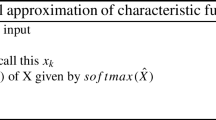Abstract
The generating function of the autocorrelations of the interdeparture times in stationary M/G/1 and GI/M/1 systems involves the probability generating function of the number of customers served in a busy period. The latter function is implicitly determined as a solution to a functional equation. Standard methods for the numerical inversion of generating functions require the values of these functions at many complex arguments. A recently discovered substitution method for contour integrals allows the numerical inversion of implicitly determined generating functions without the numerical solution of the functional equations.
Similar content being viewed by others
References
J. Abate and W. Whitt, The Fourier-series method for inverting transforms of probability distributions, Queueing Systems 10 (1992) 5-87.
J. Abate and W. Whitt, Numerical inversion of probability generating functions, Oper. Res. Lett. 12 (1992) 245-251.
J. Abate and W. Whitt, Solving probability transform functional equations for numerical inversion, Oper. Res. Lett. 12 (1992) 275-281.
J.P.C. Blanc, On the numerical inversion of busy-period related transforms, Oper. Res. Lett. 30 (2002) 33-42.
P.J. Burke, The output of a queueing system, Oper. Res. 4 (1956) 699-704.
G.L. Choudhury, D.M. Lucantoni and W. Whitt, Multi-dimensional transform inversion with applications to the transient M/G/1 queue, Ann. Appl. Prob. 4 (1994) 719-740.
J.W. Cohen, The Single Server Queue, 2nd ed. (North-Holland, Amsterdam, 1982).
D.J. Daley, The correlation structure of the output process of some single server queueing systems, Ann. Math. Statist. 39 (1968) 1007-1019.
D.J. Daley, Queueing output processes, Adv. Appl. Prob. 8 (1976) 395-415.
P.D. Finch, The output process of the queueing system M/G/1, J. Roy. Statist. Soc. Ser. B 21 (1959) 375-380.
J.-Q. Hu, The departure process of the GI/G/1 queue and its MacLaurin series, Oper. Res. 44 (1996) 810-815.
J.H. Jenkins, On the correlation structure of the departure process of the M/E?/1 queue, J. Roy. Statist. Soc. Ser. B 28 (1966) 336-344.
J.F.C. Kingman, On queues in heavy traffic, J. Roy. Statist. Soc. Ser. B 24 (1962) 383-392.
K.T. Marshall, Some inequalities in queueing, Oper. Res. 16 (1968) 651-665.
C.D. Pack, The output of an M/D/1 queue, Oper. Res. 23 (1975) 750-760.
E. Reich, Waiting times when queues are in tandem, Ann. Math. Statist. 28 (1957) 768-773.
D.V. Widder, The Laplace Transform (Princeton Univ. Press, Princeton, 1941).
Author information
Authors and Affiliations
Rights and permissions
About this article
Cite this article
Blanc, J. Computation of Autocorrelations of Interdeparture Times by Numerical Transform Inversion. Annals of Operations Research 112, 83–100 (2002). https://doi.org/10.1023/A:1020976904635
Issue Date:
DOI: https://doi.org/10.1023/A:1020976904635




